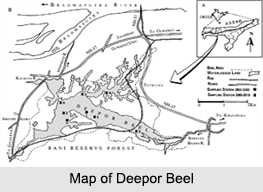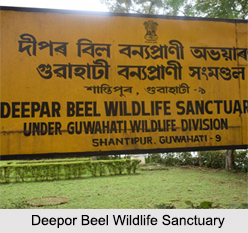 Also known as Dipor Bil, the Deepor Beel is a permanent freshwater lake, which is located to the south west of Guwahati city in Kamrup district in the state of Assam. It is part of a former channel of the Brahmaputra River to the south of the main river and is considered to be one of the largest "beels" in the Brahmaputra Valley of the Lower Assam region.
Also known as Dipor Bil, the Deepor Beel is a permanent freshwater lake, which is located to the south west of Guwahati city in Kamrup district in the state of Assam. It is part of a former channel of the Brahmaputra River to the south of the main river and is considered to be one of the largest "beels" in the Brahmaputra Valley of the Lower Assam region.
In November, 2002, under the Ramsar Convention, Deepor Beel has been listed as a Ramsar Site for undertaking conservation measures on the basis of its biological and environmental importance. The Deepor Beel is also categorised as representative of the wetland type under the Burma monsoon forest bio- geographic region.
Etymology of Deepor Beel
The name Deepor Beel means the "lake of elephants". In Assamese and Bodo dialects, a "beel" is a lake and the word "Deep-or" is said to have been derived from the Sanskrit language which stands for elephants.
History of Deepor Beel
There are no historical epigraphs or manuscripts connected to the Deepor Beel, but this does not diminish its historical significance or disconnect the lake from history. But some of the records suggest that the beel was once an important dockyard of the Ahom kingdom as well as the Mughals.
Description of Deepor Beel
Bounded by the steep highlands on the north and south, the Deepor Beel has a picturesque backdrop of the U shaped valley along with the Rani and Garbhanga hills. The freshwater lake has an average depth of 1m that can extend up to 5m and has a perennial water spread area of about 10 km sq. which extends up to 40 km sq. during floods.
 Between the months of May and September, the Basistha and Kalmani rivers and local monsoon run-off are the main sources of water to the lake. During the monsoon season, the Khonajan channel acts as a natural storm water reservoir as the channel drains the beel into the Brahmaputra River.
Between the months of May and September, the Basistha and Kalmani rivers and local monsoon run-off are the main sources of water to the lake. During the monsoon season, the Khonajan channel acts as a natural storm water reservoir as the channel drains the beel into the Brahmaputra River.
There are 12 villages on the periphery of the Deepor Beel, the inhabitants of these villages use the beel for a variety of activities. Primarily facilitating fishing and raising rice paddy, the beel also acts as a waterway for transporting the villagers of the southern boundary to the National Highway 37.
But over time with the proliferation of human settlements and other natural and anthropogenic causes has resulted in the deterioration of the beel. Steps are being taken by the government to improve the condition of the beel and thus a comprehensive management plan has been set in motion and it is proposed to notify the whole Deepor Beel area as a protected area.
Thus the Guwahati Waterbodies (Preservation and Conservation) Bill, 2008 has been passed with the objective of preserving the wetland and to re-acquire land in the periphery of Deepor Beel, to undertake development projects, including water sports at the beel.
Flora and Fauna of Deepor Beel
Based on the Deepor Beel"s ecological adaptation, the hydrophytic vegetation of the beel has been classified accordingly. Submerged, emergent and floating vegetation like Giant Water Lily, water hyacinth, aquatic grasses and water lilies are part of the aquatic vegetation during the summer season. The deciduous forests are a dominant type of tree species, the beel also offers other types of flora like medicinal plants and orchids, which are of commercial value.
The Deepor Beel is a natural habitat to varieties of birds and thus an area of 414 hectares has been declared as Deepor Beel Bird Sanctuary by the Government of Assam. The sanctuary has over 120 species of birds including kingfishers, fishing eagles, adjutant storks, Siberian cranes and abundant varieties of ducks. The largest congregations of aquatic birds can be seen here with a recorded count of about 19,000 water birds in a day. There is also a watchtower on the bank of the beel for bird watching.
Surveys conducted around the area has revealed that the Deepor Beel also has a rich aquatic fauna comprising of 20 amphibians, 12 lizards, 18 snakes and 6 turtle and tortoise species. Other types of fauna included the Wild Asian elephants, leopard, jungle cat and the protected barking deer, Chinese porcupine and sambar.
Visiting Information on Deepor Beel
The Guwahati railway station is the closest at a distance of almost 18 km from the beel and the Lokpriya Gopinath Bordoloi International Airport is the nearest at 10 km away from the Deepor Beel.



















